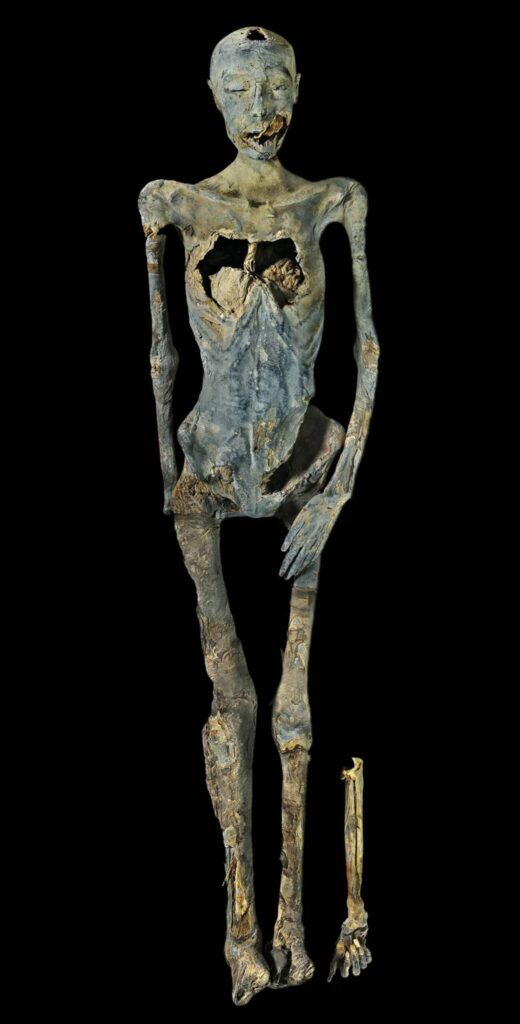In ancient Egyptian history, the mysteries surrounding the pharaohs and their families have long captivated researchers and explorers. One of the most intriguing figures is “The Younger Lady,” believed to be the mother of King Tutankhamun and closely related to other prominent members of the 18th Dynasty. Although her identity has not been definitively confirmed, “The Younger Lady” remains an essential part of the study of this royal family.
A Significant Discovery: The Mummy of “The Younger Lady”
In 1898, archaeologist Victor Loret discovered a female mummy in tomb KV35, located in the Valley of the Kings. This mummy would later be known as “The Younger Lady.” She was identified as Tutankhamun’s mother through genetic analysis, with clear familial connections, and as the full sister of the mummy found in tomb KV55, commonly believed to be Akhenaten, although this identification is still debated.
Interestingly, in the same tomb, Loret also found the mummy of Tiye, the Great Royal Wife of Pharaoh Amenhotep III and the mother of “The Younger Lady.” Another mummy of a young boy, possibly Prince Thutmose, the son of Amenhotep III and Tiye, was also discovered in the same tomb. For many years, Tiye was referred to as “The Elder Lady,” until evidence of her identity emerged. A lock of hair found in Tutankhamun’s tomb, labeled as his grandmother’s hair, was a perfect match to the hair found on Tiye’s mummy, conclusively identifying her.
Theories About the Identity of “The Younger Lady”
Although the blood relations of “The Younger Lady” are clear, her exact identity remains a subject of debate. Scholars and Egyptology enthusiasts have put forward various theories regarding who she might have been. Some suggest she could be Kiya, a secondary wife of Akhenaten, while others propose that she might even be Nefertiti, the famous wife of Akhenaten and the mother of other well-known pharaohs such as Tutankhamun. However, these theories are speculative, and as of now, there is no conclusive evidence to confirm them.
The ongoing debate over “The Younger Lady’s” identity is likely due to the complexities of royal relationships in ancient Egypt, where marriages and bloodlines were often intertwined, making it difficult to definitively identify each individual. These speculative theories highlight the mystery and intrigue surrounding the royal family of the 18th Dynasty.

Why “The Younger Lady” Matters
“The Younger Lady” is important not only because she is Tutankhamun’s mother but also because of her role in the context of ancient Egyptian history. As the daughter of Amenhotep III and Tiye, “The Younger Lady” witnessed the dramatic shifts in Egypt, from the prosperity of her father’s reign to the religious upheaval under Akhenaten’s rule.
Additionally, through recent genetic studies, it has been confirmed that “The Younger Lady” was directly related to other prominent figures in the royal family, such as Akhenaten (potentially her brother) and Tutankhamun (her son). This provides a clearer understanding of the royal bloodline of 14th-century BCE Egypt and how the pharaohs’ traits and lineage were passed down through generations.
Fascinating Discoveries in Genetic Analysis
One of the most significant developments in understanding Tutankhamun’s family has been the application of genetic analysis. DNA testing has helped confirm the relationships between the mummies found in tomb KV35, linking “The Younger Lady” to Tutankhamun. Recent genetic research has also revealed inherited diseases, such as bone deformities, which affected both Tutankhamun and other members of the royal family. These discoveries provide valuable insight into the health and medical conditions of the pharaohs, as well as the broader picture of life in ancient Egypt.
Conclusion
While the identity of “The Younger Lady” has yet to be definitively determined, the discoveries surrounding her and her royal family continue to raise fascinating questions about the history and legacy of the pharaohs. Whether she is Tutankhamun’s mother or potentially a key figure like Akhenaten’s wife Kiya or Nefertiti, her story remains a captivating subject for Egyptology. With every new discovery, we move closer to unraveling the mysteries of the 18th Dynasty of ancient Egypt, a time marked by political, religious, and familial complexity.
